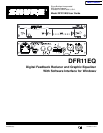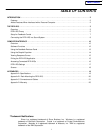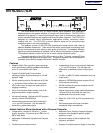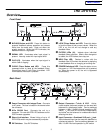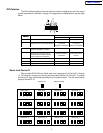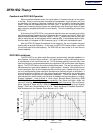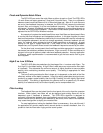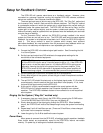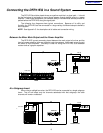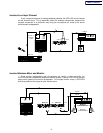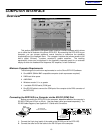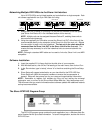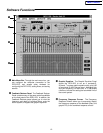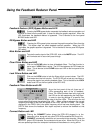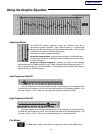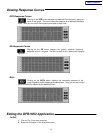6
Fixed and Dynamic Notch Filters
The
DFR1
1EQ can control the notch filters as either
dynamic
or
fixed.
The
DFR1
1EQ’s
10 notch filters are factory preset as 5 fixed and 5 dynamic filters. There is no difference
between
dynamic and fixed filters until all 10 filters have been set. After
all 10 notch filters are
set and a new feedback frequency is detected, the DFR11EQ will remove the oldest set
dynamic filter and re-deploy it at the new feedback frequency. The fixed filters remain
unchanged.
However
, if feedback occurs at the same frequency as an existing dynamic or
fixed
filter
, the existing filter will deepen. The number of fixed versus dynamic filters can be
adjusted
via the DFR1
1EQ’
s Windows interface.
An
example of
a system that would benefit from more fixed filters and less dynamic filters
is
one that has fixed microphone and loudspeaker locations. In this type of system, the most
dominant
frequencies
of feedback are defined by the room dimensions and the microphone
and loudspeaker placement, and will not change appreciably. However, feedback can still
occur, for instance, when someone’s hand or head approaches a microphone. A good
setting for this type of system would be 7 fixed filters for the non-changing feedback
frequencies,
and 3 dynamic filters to catch the feedback frequencies caused by the talker
.
On
the other hand, more dynamic than
fixed filters would be appropriate in a system that
has
several non-stationary wireless microphones.
Eight or even all 10 filters could be set to
dynamic
in this type of system to obtain maximum feedback protection. As every application
is different, some experimentation is recommended to get the best results from a given
sound
system.
High Q vs. Low Q Filters
The
DFR1
1EQ of
fers two selections for the shape of the
1
/
10
-octave notch filters.
The
first,
High Q, is the default setting. A High Q
filter
’
s width stays very narrow as the filter depth
is increased. This attenuates the minimum amount of signal possible to ensure system
stability, while maintaining excellent sound quality. This setting is appropriate for most
applications.
The
Low Q setting maintains the filter
’
s shape as it is deepened, so the width of the
filter
effectively widens as the depth increases. Using this setting attenuates the signal more,
producing a greater system stability than the High Q setting, but with slightly diminished
sound quality. This setting is appropriate for systems such as a speech-only PA where
stability
is an absolute must, but the sound quality can be compromised a bit.
Filter Locking
The
feedback filters can be locked from the front panel of the unit or from the computer
interface. When locked, new filters will not be deployed and existing filters will not be
deepened, even if feedback is detected. The DFR11EQ’s algorithm is designed to
accurately differentiate feedback from non-feedback sounds such as speech. However,
certain sounds such as electric guitar feedback or test tones, which sound like feedback,
may
cause the algorithm to deploy an unwanted filter
.
For
most applications, locking the feedback filters is unnecessary
. As a rule of thumb,
if
the application will contain material which sounds similar to acoustic feedback, then it is
prudent
to lock the filters after ringing out the sound system.
Main Menu



